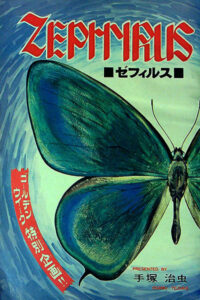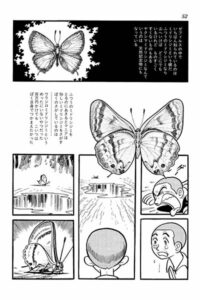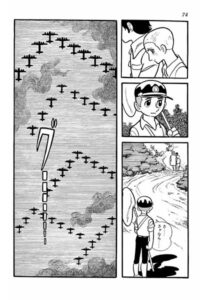Zephyrus (Manga)
also known as ゼフィルス (Zefirusu)
| English Title: | Zephyrus |
| In English? | No |
| Japanese Title: | ゼフィルス Zefirusu |
| Type: | Short Story |
| Original run: | 1971/05/23 |
| Published in: | Weekly Shonen Sunday 少年サンデー |
| Published by: | Shogakukan |
| Volumes: | 1 (MT-126) |
The semi-autobiographical short story Zephyrus (1971) was originally published as a short story in the May 23, 1971 issue of Weekly Shonen Sunday.
What it’s about
Near the end of World War II, as the allied air raids over Japan intensified, people began preparing for the eventual invasion of their homeland. However, amidst the military, there was a boy who escaped the chaos by chasing and collecting butterflies in the forests outside his village. Although he was interested in all sorts of butterflies, there was one he prized above all others – the favonius saphirinus, also known as the “Shijimi Urajiro” – the rarest of all the Zephyrus butterflies.
Once he spots a Zephyrus, in the woods, he vows to capture it at all costs. However, the Zephyrus is like a wood fairy, and remains elusive. Undaunted, he returns to the same forest paths, day after day tracking his quarry. He’s there so often that a local farmer and his wife mistake him for a thief that’s been stealing their potato crops. Feeling the sting of their accusation, and wanting to clear his good name, the boy hides out one night to catch the real culprit – and sure enough, he does.
However, after a chase through the woods, he discovers that the thief is in fact just a young orphan boy who is trying to get food to support his sick sister. The two boys become friends and the pair of them often go out hunting for the Zephyrus together.
Then, one day – just as he’s about to finally nab the Zephyrus in his net – the boy is stopped by a strange man asking about the whereabouts of a man and a woman. The boy lets slip about his new found friend, and the man is revealed to be an agent of the secret police who is hunting a deserter. With no choice, the boy takes the man to his friend’s hideout and discovers the truth – the “boy” and his “sister” are in fact a woman hiding her deserter boyfriend.
The boy can do nothing but watch sadly as the pair are taken into custody. And then, in a cruel twist of fate, a few days later the allied firebombs burn down the forest, leaving the boy no chance to catch his long sought butterfly.
Thirty years later, the boy, now a middle-aged man, returns to his hometown, but there’s no sign of the Zephyrus – but ever so often he sees a child with a butterfly go by, and he still holds out hope for their return.
What you should know
In the 1970s, Osamu Tezuka suddenly began publishing thinly veiled autobiographical short stories of his war-time experiences. The exact reasons for this are unclear, but it is likely the product of a combination of factors – the never-ending war in Vietnam, Tezuka’s own professional issues starting to rear their head, the social change going on in Japan, and the outside influence of other manga artists beginning to tackle the subject.
As such, Zephyrus (1971) can be considered the first among a group of stories that also includes The Godfather’s Son (1973), Paper Fortress (1974), Hungry Blues (1975), Mount Monmon is Crying (1979), and Pornographic Pictures (1979-80) which depict various facets of Tezuka’s wartime experiences and more directly convey his anti-war themes than much of his earlier work.
Unlike the later stories, in Zephyrus (1971), Osamu Tezuka still seems hesitant to cast himself directly as the antagonist, but as most of his fans will know, Tezuka had a lifelong fascination with insects. So, the nameless boy who has a deep love of butterfly hunting can certainly be seen as his stand-in.
One the one hand, the story serves as an opportunity for Tezuka to present an almost textbook-like precise on a rare butterfly – educating his reader through the use of the proper latin terminology and extremely accurate and life-like illustrations. On the other hand it shows how, ultimately, there was no escape from the realities of war. Although the boy can escape then endless marching and other civil defence-related activities for a short time, the war eventually catches up with him. His own single-minded hunt for an elusive butterfly mirrors the Japanese secret police’s unwavering attempts to track down and punish military deserters, showing that even in the relatively peaceful green woods, the war still intrudes. This is made even more obvious when the boys is faced with the utter destruction of everything he loves – and even more poignant by his later return 30 years later (which would have been modern day at the time the story was first published in 1971) to show that the opportunity has been seemingly lost forever.
What else you should know
Given it’s publication in the Osamu Tezuka Complete Manga Works edition (MT-126), Zephyrus (1971) may be considered part of the “Tiger Books” short-story anthology series. However, unlike some other short-story anthologies, such as Under the Air (1968-72), Clockwork Apple (1968-73), and The Crater (1969-70), this is a very loose affiliation.
Stars Spotted:
-
- Shunsaku Ban as “the farmer”
- Zephyrus as “the Zephyrus butterfly fairy”





